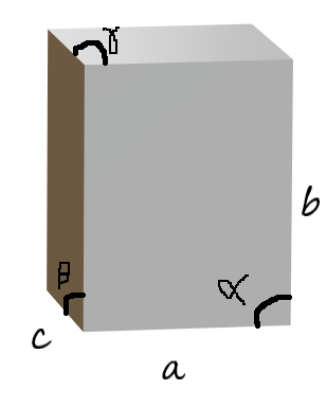
In the tetragonal crystal system, which of the following is true?
A. All axial lengths and all axial angles are equal
B. All three axial lengths are equal
C. All three axial angles are equal
D. Two axial angles are equal but the third is different
Answer
495.9k+ views
1 likes
Hint: Here, we have to have the knowledge about crystal systems and their structures. Knowing the structures we can know whether the angles and lengths are equal or not. Crystallography is the study of crystals systems and lattice systems.
Complete step by step answer:
Here, it is important that we discuss the tetragonal crystal system in detail. Let’s first start with talking about crystallography and crystal systems.
In crystallography, the Crystal system, crystal family and lattice system refers to several classes of space groups, lattices, point groups and crystals. They are commonly confused with each other but are slightly different from each other. There are seven crystal systems which are Isometric. Tetragonal, Orthorhombic, Hexagonal, Triclinic, Monoclinic and Rhombohedral crystal systems.
Tetragonal crystal system is one of the seven crystal systems. Tetragonal Crystal lattices are formed as a result of stretching a cubic lattice along one of its lattice vectors. So, a cube becomes a rectangular prism with a square base. Examples of tetragonal crystal properties include apophyllite, zircon, rutile quartz and scheelite.
The structure of Tetragonal crystal system is as given below:

The sides a, b and c are called the axial lengths. The sides a and c are equal in length. But length b is different in length. That is
The angles alpha, beta and gamma are called the axial angles. The angle between sides a and b is called alpha (
Therefore, our answer is option C.
Note:
One should know the structures of every compound or crystal system to get the answers of every structural related question of any compound.
Complete step by step answer:
Here, it is important that we discuss the tetragonal crystal system in detail. Let’s first start with talking about crystallography and crystal systems.
In crystallography, the Crystal system, crystal family and lattice system refers to several classes of space groups, lattices, point groups and crystals. They are commonly confused with each other but are slightly different from each other. There are seven crystal systems which are Isometric. Tetragonal, Orthorhombic, Hexagonal, Triclinic, Monoclinic and Rhombohedral crystal systems.
Tetragonal crystal system is one of the seven crystal systems. Tetragonal Crystal lattices are formed as a result of stretching a cubic lattice along one of its lattice vectors. So, a cube becomes a rectangular prism with a square base. Examples of tetragonal crystal properties include apophyllite, zircon, rutile quartz and scheelite.
The structure of Tetragonal crystal system is as given below:

The sides a, b and c are called the axial lengths. The sides a and c are equal in length. But length b is different in length. That is
The angles alpha, beta and gamma are called the axial angles. The angle between sides a and b is called alpha (
Therefore, our answer is option C.
Note:
One should know the structures of every compound or crystal system to get the answers of every structural related question of any compound.
Latest Vedantu courses for you
Grade 11 Science PCM | CBSE | SCHOOL | English
CBSE (2025-26)
School Full course for CBSE students
₹41,848 per year
EMI starts from ₹3,487.34 per month
Recently Updated Pages
Master Class 12 Business Studies: Engaging Questions & Answers for Success

Master Class 12 English: Engaging Questions & Answers for Success

Master Class 12 Social Science: Engaging Questions & Answers for Success

Master Class 12 Chemistry: Engaging Questions & Answers for Success

Class 12 Question and Answer - Your Ultimate Solutions Guide

Master Class 11 Business Studies: Engaging Questions & Answers for Success

Trending doubts
Draw a labelled sketch of the human eye class 12 physics CBSE

a Tabulate the differences in the characteristics of class 12 chemistry CBSE

Which one of the following is a true fish A Jellyfish class 12 biology CBSE

Why is the cell called the structural and functional class 12 biology CBSE

Differentiate between homogeneous and heterogeneous class 12 chemistry CBSE

Write the difference between solid liquid and gas class 12 chemistry CBSE




